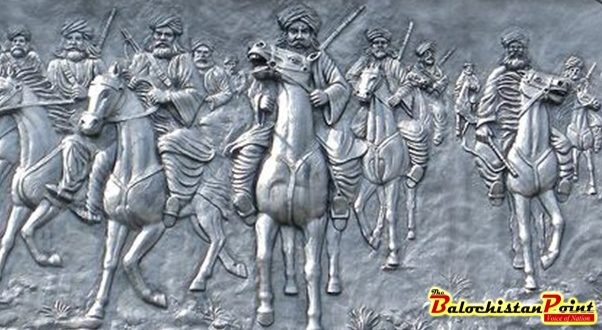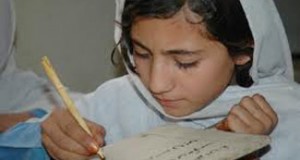By: Aziz Ejaz
During fifteenth and sixteenth centuries the European nations showed very curious moves for exploration of overseas trade and their supremacy in distant seas and lands, resultantly in 15the century the first king of Portugal decided to send a naval mission under the supervision of Vasco Da Gama, an explorer and first Admiral of the Seas, who was one of the most successful voyagers in the Age of discovery and the commander of the ship that sail from Europe to India just for accomplishment of the profitable ports of the Indian Oceans. This organized voyaging team lunched its expedition by the order of the king of the Portugal Umma Notal to turn its face towards the cost of Arab peninsula including the coastline of sub-continent by sea. At the first their purpose of expedition was to just voyage but the blanket realities became disclosed when they divided the entire coastline of Arab and sub-continent into three haves.
This historic mission of voyage sailed off on July 8, 1497 from Lisbon, the capital Portugal to Calicut (Kolkata) on the south Indian Coast. They travelled via different ports and eventually, reached Calicut, India, establishing a trading station at Goa, India on August 29, 1499, they finally after such a gigantic succession returned to their home back putting down the foundation of the Portuguese Empire in Asia.
This policy of dividing the Arab peninsula and the sea of sub-continent was carried out by Daan Prince Koraay lamaida. At that time, the notified viceroy was accompanied by the commanders of Portuguese army including the most influential name, Vasco Da Gama. The division of this in its real sense was a sort of expansion that cleared the ground interests of Portuguese in this region what they wanted to fulfill for a longtime. In that three parts of division, the first was comprised by ‘’Ihmar’’ (Arabian Peninsula), the 2nd was divided as ‘’Cape Jacques’’, (the Indus coastal areas) in which the Makuran coastal was included as like Gwadar, Calera, Tribiqeu, Kalmat and Daibal. The 3rd was beginning from Daibal till Indian Gujarat’s Coast.
The expansionist thoughts of ruling the cost of this region appeared in the shape of dividing the coastline into many haves in order to get ease for proceeding of their voyaging excursion, as they wanted to take the entire region in their strong presiding claws. Vasco Da Gama, a Portuguese explorer is called the first person who used to voyage the entire section of this above mentioned cost in the world firstly. Vasco Da Gama’s expeditions from Europe to reach India by sea was very significant and paved a way for the Portuguese to establish a long lasting colonial empire in Asia. The ship by which they (European excursionists) were sailing was being positioned by Vasco Da Gama. The route cleared by Vasco Da Gama’s voyaging team was only meant that the Portuguese should voyage safely without any need of crossing the highly Mediterranean and dangerous Arabia and this way surely allow them for their accomplishing ground realities.
At that time there was a great concern of it that when a king of a state wanted to rule out a specific region then it was a compulsory task first to take the site that leads to assault on any state or region because that was a time of straightforwardness and there have not been any disparaging weaponry source which today the most violent world has to utilize for the purpose of taking over the regions and others disparaging purpose. The only way by which the kings succeeded was to go through water way. Historians mention the army that came from Portugal enjoyed the divided haves of this cost section to precede their expansion as long as it becomes possible. In 15th century, they have successfully captured some of the parts of India and Oman latter the planned to proceed for the annexation of the coastal areas of Makuarn as well because in the division plan of Indian sea and Arab peninsula, which was performed in 1506 was comprised of Balochistan’s sea along with Cape Jacques.
In it the Makuarn coastal line was included which was used for the Portuguese to carry out their expedient voyage and whenever they became in need of anything they came to fulfill their life saving items, like water and nutritional goods from the native of coastal suburbs. With the passage of time the Portuguese initiated plundering the inhabitants of the coastal areas and this fierce injustice of the Portuguese army compelled them to raise a voice in the form of resisting the policy as the army set the homes and other luggage on fire on the eve of their daily exploitation. Seeing the situations the inhabitants proceeded to the tribal Chief Mir Ismail Baloch who was the grandfather of Mr. Hamal Hoth Kalmati, who was the tribal chief of the area. Courageously, the chief managed to resist the Portuguese as they were crossing the limits of tolerance, as for as their assaults on the poor people of Gwadar, Pasni and Kalmat were concerned. And On the other side, they were taking the advantage of coast at time they want for the purpose of plundering, but it is a well said proverb, ‘’ Grasp all, Lose all’’. Being intolerable owing brutalities of the foreigner, on the eve of this: Mir Ismail Baloch supervised an organized army against the Portuguese. So that they couldn’t become able to capture the coastal areas of Makuran and eventually the Portuguese were defeated many times under the supervision of Ismail Baloch. He struggled a lot for the Baloch in coastal area to live in peace.
Ismail’s attempts bore a fruit by defeating the Portuguese during 15th century as they were enjoying the most parts of the Arabian Sea, Makuran Sea and the Indian one’s. He kicked the bucket in 873 Hijri and his grave is situated there in the Batal Mountain (is in Gwadar, near the famous Port) which was constructed in his lifetime. He was the person who listened thoroughly the request of victims and assured them for a response ironically, as he showed it by defeating the cruel army of Portuguese.
After his death Mr. Hamal Kalmati took the responsibility of regime and became the ruler of Makuran, was his nephew and son of Mir Jihand Khan Kalmati. Kalmati is a Baloch tribe in Balochistan, they live in Kalmat and the name Kalmati has been derived from it, is situated on the border of Iran. Basically the tribe belongs to Mir Hoath; Hoath was son of Mir Jalal Khan. Historian mention, when the Hoaths were ruling on Makuran, a few members of the Hoath tribe settled in Kalmat Bandar (Kalmat Port), which is situated near the port of Pasni. It was about 11th to 12th century, the ruling Hoaths (Kalmat) spread from western Balochistan to Sindh, as Kalmat live in areas of Shah Bandar in Sindh. Today if we want to get a glance at the identity of Hoaths, than we can find them in some places of Iran like, ChahBahar and in Sindh province as well such as, Malir, Gadap town and Layari, Matyari,Tando Adam, Hyderabad and Thatta, In Balochistan; Dashti, Pallire, Jiwani, Baho, Dashtayri, Gwadar, Pasni and Hub.
During the ruling duration of Mir Hamal Kalmati, the Portuguese repelled a number of attacks and lunched many assaults under the leadership of commander of Portuguese ‘’ Lowees Dee Almia’’ Mir Hamal Kalmati in his ironic response to the assaults of Portuguese arranged an organized army and constructed a ship known as ‘’Shaahg’’ to be used for the purpose of war against Portuguese in the coastal areas and sea.
Alarmingly, on that time, there have been many witnesses of conflicts between Hamal Kalmati and the Portuguese. Resultantly, the Portuguese were defeated brutally on each attempt they lunched. The courage and bravery of Hamal Kalmati earned for him a great name in Baloch history as he is mentioned the only person from Baloch who fought in defending the mud of motherland.
In the pages Baloch history, we can come across to many wars and reverend names: such as, the war of thirty years fought between Rind and Lasharee, Mir Lord Doda Khan and Boladahee, the war of Delhi and many more but all of the wars were fought on the bases of some traditional convulsions violation and in lord and lordships compares.
This sort of bravery has been shown by the Hoaths living in Karachi as well, on 2nd February 1839, when two British military ships boarded in Manora Port (Karachi Port) and the British army called the tribes to evacuate the port and surrender arms, the Kalmati tribal commander refused the surrender call. This was the time when the British Empire colonial expansion was spreading its grasp over sub-continent and the Manora Port was being supervised or handled by the Hoaths tribe. ‘’ According to historians and legends, tribe chief replied, ‘’I am a Baloch and would prefer to be a martyr than to surrender’’.
Mir Hamal Kalmati devoted his life for the inhabitants of his ruling areas. After many such defeats ‘’ lowees Dee Almia’’ the commander in chief made a pact with Mir Hamal Kalmati, In which many clauses were given and an end of, and one of the clause it contained was that the Portuguese will not attack the Makuran coastal area. This pact allowed in recovery of peace and people used to initiate their normal lives in coastal areas again.
But after a passage of time, one day, when Mir Hamal Kalmati set a plan of haunting in sea with his companions and friends. they underway a sailing on their Shaahg: ‘’famously known Hamal’s ship made during the conflicts with Portuguese’’ during the voyage an unfortunate tsunami arose with a great intensity that took the ships into its layers and the ship erratically starting moving here and there which was not coming in their hold, the storm eventually took the ship very remote till the cost of India.
The ship reached in the coast of Gujarat’s which was already in claws of Portuguese, seeing the ‘’Shaahg’’ and Mir Hamal Kalmati, the Portuguese breathed a fresh air and took the ship into siege and called Hamal for surrendering which the legend Mir Hamal Kalmati refused and indented to fight with the attacking army.
Mir Hamal Kalmati’s Territorial Army strength was not that much strapping as compare with Portuguese but still many tributes goes to Mir Hamal Kalmati courageousness performance and bravery that prefer fighting and accompanying by his friends initiated to fight rather than surrender. Hamal with his friends fought tyrannically and fighting got intensification from both sides when they came in front of each other, the Portuguese seeing the circumstances irrepressible managed to throw a net over to Hamal’s ship in order to arrest him and eventually, they captured Mir Hamal Kalmati and his friends by the help of a net and took them to Indian coat which was already in occupation of Portuguese’s long lasting colonial empire, likewise the Portuguese broke the pact and after abducting him to an unidentified place and some historian said, Hamal has been shipped to Portugal after keeping him in an area known as Goa, India.
The Portuguese offered Mir Hamal Kalmati for marrying a girl in their country, even they have also offered him with many concessions but he refused to do it, as historian mention.
The ‘statue’ of Mir Hamal Khan is lying in an island museum in Ghana in India, which was constructed by the Portuguese. There are many evidences regarding the war with Portuguese as it was mentioned in the book of Mr. R. Huges Buller ‘’ Makran Kalmatis’’, ‘’that the Kalmatis snatched weapons from the Portuguese had been seen in 1904 in the Port of Balochistan’’.
Mir Hamal Kalmati was not only a Chief of a tribe, he was the one who had struggled a lot for the civilian rights, whose devotion is a great emblem for the young generation of Baloch that how to serve for a specific purpose and safety of the land that is our mother.
Published in The Balochistan Point on October 11, 2017
 Balochistan Point Voice of Nation
Balochistan Point Voice of Nation




